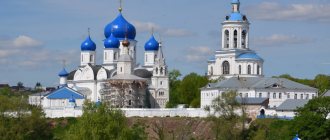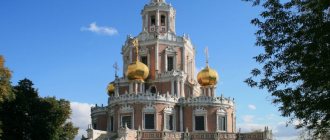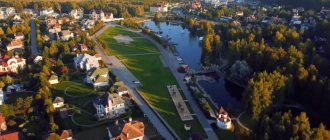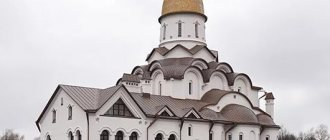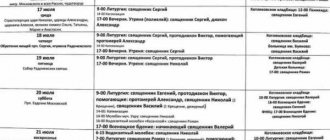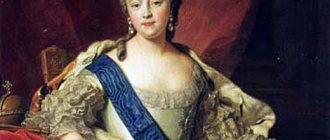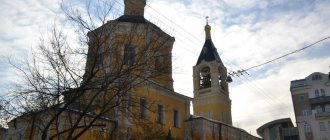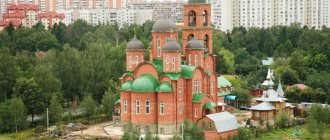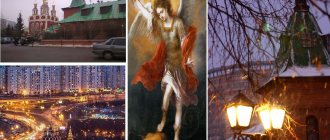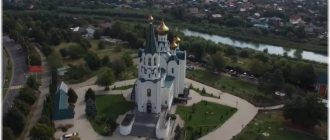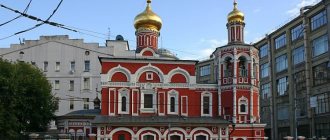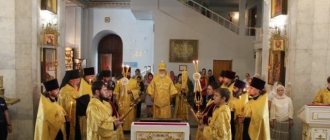The city of Moscow is undoubtedly one of the oldest capitals of our world. Its architecture took shape over almost a millennium.
Among the buildings of the city you can find modern buildings made of glass and concrete, and monuments of ancient architecture. The pearl of the capital can be called the Kremlin, which was once a fortress, now surrounded by churches and museums of all eras.
But if you focus only on the masterpieces of past years, then you easily miss many modern temples and simply beautiful buildings.
Temple to Equal-to-the-Apostles Prince Vladimir in Kuzminki, made entirely of wood
One of these churches was the Vladimir Church, which is located in the very center of Kuzminki.
The building project was prepared over the course of a whole year and meant a full-fledged stone structure. However, due to legislative delays, the church was made of wood.
Later, they wanted to clad the temple in stone, but the parishioners and residents of the surrounding houses opposed it. The wooden church turned out amazingly good.
Now services are regularly held there, not only for cadets located near the school, but also for everyone.
Church history
The first mention of the church dates back to 1716. It was a wooden church belonging to the Stroganov family. It was built to store a church relic - the Blachernae icon. It was in honor of this icon that the temple later began to be called the Blachernae Church. In 1732 the church was destroyed by fire. The newly rebuilt church was also built from logs.
In 1732 the church burned down for the second time. It was restored in wood again, but it served parishioners only until 1758, burning down for the third time that year. At this time, the estate belonged to the Golitsyn family. They decided to recreate the destroyed structure from stone. The building was designed in the style of early classicism. Construction was completed in 1774, but soon the building needed repairs. It lasted until 1787. As a result of repairs, a stone bell tower was added to the church.
During the invasion of Napoleonic troops into Russian territory, the temple was destroyed. In 1813 it was restored for the 4th time.
The Blachernae Church in Kuzminki (the schedule of services can be found on the church website) was closed with the advent of Soviet power in 1928. A dormitory was placed in the building. The Blachernae icon was transferred to the Assumption Church. After the closure of the Assumption Church in 1940, the shrine ended up in the Tretyakov Gallery. There she is now.
The Blachernae Church, Kuzminki had a unique Blachernae icon.
After 1929, the church ceased to be considered a religious monument. It was rebuilt and over the years it housed a dormitory and a holiday home. The new life of the temple began in 1992. It was handed over to the Orthodox Church and restoration began. Restoration of the building took 2 years. It took another year to restore its decoration and functions. In 1995, the church was consecrated and opened to believers.
Moscow Church of St. Prince Vladimir in the Old Gardens
| Church of St. Prince Vladimir in the Old Gardens |
The most famous church in Moscow, consecrated in the name of the holy Equal-to-the-Apostles Prince Vladimir, who baptized Rus' into the Christian faith in 988, is located in Starosadsky Lane on Ivanovskaya (or Alabova) Hill near Kulishki.
It offers a beautiful view from Solyanka and Slavyanskaya Square - in ancient times this church was a house church at a country grand-ducal courtyard, and was considered a palace church, and then became an ordinary parish church. This area has been known in Moscow history since the beginning of the 15th century - the Vladimir Church was first mentioned in 1423 in the spiritual letter (testament) of Grand Duke Vasily I, the eldest son of Dmitry Donskoy. Here, in a picturesque place with a forest not far from the Kremlin, his summer palace was first built with a house church, consecrated in the name of the great ancestor of the Russian and Moscow princes. Here, next door, in Trekhsvyatitelsky Lane stood the country house of the Moscow Metropolitan, which proves how privileged this territory was in the old days.
Historians believe that it was Grand Duke Vasily Dmitrievich, and not his grandson Ivan III, who first laid out here, at the palace, the famous princely orchards with luxurious fruit trees - their fresh fruits were served directly to the sovereign’s table, and between Pokrovka and Myasnitskaya there were apple trees for a long time shopping arcades. And Grand Duke Ivan III carried out his grandfather’s plan on a grand scale, laying out a huge Sovereign’s Garden here - his domain stretched from Ivanovskaya Gorka to the Vasilievsky Meadow on Moskvoretskaya Embankment. When later, in the 16th century, the Sovereign Garden was laid out in Zamoskvorechye on Sofiyka - in no small part in order to protect the Zarechye from fires and free this territory from residential buildings, so as not to expose them to constant danger - then the Sovereign Gardens at the Grand Duke's residence on Kulishki began to be called Old Gardens, which remains in the memory of the name of the local Starosadsky Lane.
Nearby, in the area of what is now Khokhlovsky Lane, the sovereign’s gardeners also settled and took care of the trees, which is why this lane in ancient times was called Sadovnichesky. Later, this territory was settled by immigrants from Little Russia, which is why the area began to be called Khokhlovka. The mother of Tsar Mikhail Fedorovich, nun Martha, built a magnificent Trinity Church there, then rebuilt in the “Naryshkin Baroque” style - its Old Moscow address was the same as that of the Vladimir Church - “in Old Gardens”.
A new era in the history of the Grand Duke of Vladimir Church began under the son of Ivan III, Grand Duke Vasily III. In 1514, after the capture of Smolensk, he ordered the foundation of 11 city parish churches - “stone and brick” in Moscow “in a large settlement behind the market”, and entrusted the work to his court architect, the famous Italian master Aleviz Fryazin, who built the Archangel Cathedral in the Kremlin. Among these newly built churches were the Vvedenskaya Church on Lubyanka and the famous Church of St. Barbarians in Kitay-Gorod at the foot of the Kremlin, and the Annunciation Church on Vorontsov Field (now Ilyinskaya), and the Alekseevskaya Church in the monastery of the same name on Volkhonka, and the unpreserved Leontief Church “behind Neglinnaya” near Mokhovaya - and the Vladimir Church in Starye Sady.
There is a version that it was Vasily III who ordered the construction of a new chapel in it in the name of Sts. Kirik and Iulitta, although all data indicate a later origin of this chapel and date its appearance to the second half of the 17th century. One way or another, the beautiful white church, built by master Aleviz, was consecrated already in 1516.
And soon the gigantic Ivanovo Monastery grew up next to it - according to one legend, founded also by Vasily III in honor of the birth of his heir, named John - the future Tsar Ivan the Terrible. The place indeed continued to remain “the sovereign’s”, and from the end of the 16th century, boyars began to willingly settle here. Among them were the Shuiskys - their ancient stone chambers still stand in the quiet Podkopaevsky Lane.
Already in the second half of the 17th century, the dilapidated Vladimir Church was rebuilt, and a significant part of the old Aleviz building was dismantled and rebuilt with changes. Subsequently, the temple was rebuilt and updated more than once: after all, it burned during the Trinity Fire of 1737, when the Tsar Bell in the Kremlin was forever damaged by fire, and in 1812. After the expulsion of Napoleon from Moscow, the actual state councilor Mikhail Volsky submitted a petition for the restoration of the ancient Vladimir temple and donated personal funds for it.
And in the same century, Mikhail Sobolev was ordained a priest in the revived Vladimir Church. He then served for a long time in various Moscow churches. In 1895, Grand Duchess Elizabeth Feodorovna herself appointed Father Mikhail as a trustee of the Elizabethan Charitable Society, and in 1908 he became the third rector of the Cathedral of Christ the Savior (after its consecration in 1883) and, already at an advanced age, served in this difficult field for 4 years . His son, Fr. Alexander also became a priest - in the now revived Annunciation Church outside the Tverskaya Gate in Petrovsky Park, where his father once served.
And over time, the modest but eminent Vladimir Church on Kulishki acquired wonderful neighbors. In addition to the aforementioned Trinity Church in Khokhlovka, the Trekhsvyatitelskaya Church at the suburban metropolitan courtyard and the Shuisky chambers, the semi-legendary house of Hetman Mazepa is hidden in Kolpachny Lane - now historians sometimes doubt whether these chambers were in fact connected with the hetman, or whether this is another old Moscow legend that The history of Moscow is so rich.
Little Russians really lived in this area - this is evidenced by local toponymy and the name of the Pokrovka section - Maroseyka. And in Khokhlovsky Lane, 7, the chambers of the Duma clerk Emelyan Ukraintsev, who at the end of the 17th century headed the Ambassadorial Prikaz and was in charge of the entire foreign policy of Russia, have survived to this day. It was he who went to Constantinople to make peace with the Turks when Peter I was preparing for the Northern War. And perhaps it was he who brought Ibrahim Hannibal, Pushkin’s ancestor, to Russia. Amazingly, Ukraintsev’s Moscow house on Khokhlovka was later associated with the name of the poet.
At the beginning of the 18th century, the Duma clerk fell into disgrace for “abuses,” and in 1709 his possession was transferred to another statesman, Prince M.M. Golitsyn, a participant in many of Peter’s battles and a commander in the Battle of Poltava. And in 1770, according to the play of history, this house again came under the jurisdiction of the Russian Foreign Ministry - the archive of the College of Foreign Affairs moved here for a whole century “to store ancient charters and copies of treaties.”
Here on Ivanovskaya Hill is an ancient, and beautiful in its antiquity, example of towers, all in narrow windows, long Diplomatic
Archive.
For our noble youth, civil life was founded in it: A breeding ground in Rus' until the present years of Leaders, dignitaries, singers. One Moscow poet wrote about him at the turn of the 19th century. However, the archive is better known for another, Pushkin quote about the “archive youths” who primly looked at Tatyana Larina. In the famous stanzas, it was this archive and its employees that were mentioned - representatives, mainly, of the “golden” noble youth who did not want to go “to the military,” and the archive was a very prestigious service in those days. Among the archive staff are the Venevitinov brothers, V.F. Odoevsky, A.K. Tolstoy, and S.A. Sobolevsky. And in the first half of the 19th century, the archive was managed by A.F. Malinovsky himself, a famous Moscow historian and friend of Count N.P. Sheremetev, who testified at his wedding to Praskovya Zhemchugova. It was under his leadership that the manuscript “The Tale of Igor’s Campaign” was prepared for publication and printed for the first time. In this archive building, Karamzin collected materials for the “History of the Russian State”, and Pushkin studied original documents, working on the “History of the Pugachev Rebellion” and “The History of Peter”. In May 1836, he was here for the last time, and, leaving home, he wrote to his wife on the way: “I was in the archives and will be forced to bury myself in them again for six months”... This was no longer destined to come true - Pushkin never came to Moscow.
In 1874, the archive was transferred from Khokhlovka to Mokhovaya, and the chambers were provided to the Moscow branch of the Russian Musical Society - they housed classes of the newly founded Moscow Conservatory, which did not yet have its own building on Bolshaya Nikitskaya. When it was built, Jurgenson's music printing house opened in a house on Khokhlovka, where almost all of P. Tchaikovsky's works were published for the first time. The composer himself once jokingly remarked that he himself would like to live in the ancient, thick walls of the “retired archive” - in a dusty and sultry, but very quiet Old Moscow alley.
And one cannot fail to mention another remarkable neighbor of the Vladimir Church - the State Public Historical Library, standing almost close to the temple building. The scientific library, or, as regular visitors call it, “Istorichka”, opened in 1936, absorbed the funds of the famous Chertkovsky public library on Myasnitskaya Street, as well as the personal library of the largest historian of Moscow, Ivan Zabelin. Its old three-story building on Starosadsky Lane - a heavily rebuilt two-story estate of the 18th century, which stood facing the courtyard - preserves the memory of Dostoevsky. Distant relatives of the writer lived here - his beloved aunt Alexandra and her husband, tea merchant A. Kumanin. The writer often visited them and described the mistress of the house in the image of the old woman Rogozhina in the novel “The Idiot.”
However, the proximity to the largest Moscow library could not but affect the fate of the Vladimir Church and bypass it during the Soviet years. In 1937, the temple began to be dismantled, but was not finished, and for a long time the building housed the stock storage of the Historical Library with hastily constructed shelves - there they burned down in a fire in 1980. Not long before that, restoration of the still closed church began, and they even erected a cross on the bell tower. Only in 1991, services were resumed in the temple, and the Ivanovo Monastery was assigned to it. Now there is a Sunday school, an Orthodox gymnasium, and a charitable brotherhood established in the name of St. Prince Vladimir.
Where is the church
The Blachernae Church in Kuzminki (the schedule of services allows you to visit it on any day) is located in the Vykhino-Zhulebino area. The name of the street on which the temple is located repeats the name of the village - Kuzminskaya. The full address of the Blachernae Church is: Moscow, Vykhino-Zhulebino district, Kuzminskaya street, 7, building 1. You can get to the specified address by metro. The station you need is Kuzminki.
To visit the Blachernae Church on your own, you will need to go the following way:
- Arrive at the Ryazanovsky Prospekt metro station.
- Go to the bus stop.
- Take bus No. 29 or minibus No. 429 heading towards Kuzminsky Park.
- Get off at the final stop “Kuzminsky Park”.
- Walk to the church building.
The temple is located at the intersection of Kuzminskaya street. and st. Old Kuzminki. From the stop you can immediately see it and you cannot pass by. The church can be reached by car. You need to turn from Ryazansky Ave. at the interchange towards the “12 Rays” park and move along the street. Academician Scriabin. After crossing the intersection with the street. Cast Iron Gates exit onto the street. Kuzminskaya and go straight to the church building. There is a parking lot near the church.
Schedule of services
The schedule of liturgies can be found on the website of the Blachernae Church or in the church itself in Kuzminki.
According to the schedule of services:
- On weekdays and Saturday mornings at 8-00 and evenings at 17-00.
- On Sunday, morning prayer begins at 7-00, evening prayer also at 17-00.
- On Orthodox holidays, additional services are held at 9:30 am.
During the festivities, evening prayer is replaced by a night vigil.
Rector of the church
The rector of the church, Mark Kravchenko, became a real spiritual guardian for many cadets and parishioners. Father Mark, after graduating from the Moscow Theological Academy, was ordained a deacon, and in 2011 he was confirmed as rector of the Church of St. Vladimir in Kuzminki.
Important! July 28 is the patronal feast of the Vladimir Church in honor of the memory of Equal-to-the-Apostles Prince Vladimir the Great.
For fidelity to the Orthodox faith and selfless work in the field of serving God in honor of the Bright Resurrection of the Lord, His Holiness Patriarch Kirill of Moscow and All Rus' awarded Father Mark Kravchenko a pectoral cross.
The rector is a permanent representative of the priesthood at all events of the Cossack Corps; he conducts educational conversations and lectures on the topic of Orthodoxy, being a military priest, which gives him the right to carry out Cossack service throughout the Federal District.
Divine service in the Church of St. Prince Vladimir
Over time, the school was renamed the Presidential Cadet School and was assigned to the troops of the National Guard of the Russian Federation.
The Vladimir Church has become a unique place; both adult Cossacks and graduates of the Cossack Cadet Corps take the oath here.
According to the cadets themselves, it was by the will and grace of the school’s patron, Prince Vladimir, that a man with a big heart, Viktor Zolotov, who holds the post of director of the Federal Service of the National Guard of the Russian Federation, became the earthly guardian of the school.
Architecture Features
Initially, the stone church in Kuzminki was planned in the style of early classicism.
This direction of architecture is characterized by:
- strict adherence to geometric proportions;
- simplicity of design combined with splendor and nobility;
- use in planning and construction of large forms;
- isolation of columns from the wall;
- preference for smooth walls over bas-reliefs.
The base of the temple was quadrangular. The main building of the octagonal church was erected on it. At first glance, the modern church building can be attributed to mature classicism. At the time of the construction of the temple in Russia, it was popular to build round-shaped churches, the so-called rattan churches. The corners of the main building were rounded, and a dome was built on the roof. Porticoes were added to the main building on four sides and entrances were cut through.
Current state
The Blachernae Church in Kuzminki (the schedule of services is easy to remember) is not inferior in decoration to the churches of the capital. The appearance of the temple was preserved during restoration. The church building consists of a central round part and an adjacent bell tower. The external and internal decoration of the temple was restored. Elite materials were used during its restoration.
Now the church occupies a central place in Kuzminki. Its white walls, surrounded by a park, attract the eye of a passerby at any time of the year. In summer, the church structure looks impressive against the backdrop of green foliage.
It is bright inside the temple. This is facilitated by many windows and light marble finishing of the room. Not only the floor, but also the iconostasis and altar are made of marble. The central aisle is decorated with a colonnade and an attic. White and blue colors predominate in the painting of the walls and dome of the interior of the temple. There is also a beige tint and gilding.
There are 3 altars in the temple. The central altar is dedicated to the main shrine of the church, the right one is dedicated to Prince A. Nevsky, and the left chapel is dedicated to St. Sergius of Radonezh.
On the territory of the temple, a sacristy - a storage room - was restored. Its architecture sets off and stands in contrast to the lightness of the temple. The turret was built in the Empire style. Its thick walls without windows, inclined towards the center, make the small building monumental. The church building, on the contrary, looks elegant and light.
Prince Vladimir
Grand Duke Vladimir is an exceptional and fateful figure in Russian history. It was he who was granted by the Lord the opportunity to present his people with the gift of the Orthodox faith. And the prince himself had the mission to perceive Jesus with his whole being. He became the bearer of Christianity, revealing to the people the joy of God's grace.
Vladimir received the title of Equal-to-the-Apostles for his deeds, which began to be equated with the deeds of the holy apostles. These figures enlightened other peoples, giving them Christianity.
When commemorated in the temple, Vladimir is called equal to the apostles. The Baptist became famous for the large-scale action that took place in the high-water Dnieper. This prince is also called the Red Sun, because from this ruler came the goodness and mercy that Baptism provided. This is the only person in Ancient Rus' who radically influenced the course of the history of his country.
Sunday School
A Sunday school at the Blachernae Church was opened immediately after the restoration of the temple began. You can sign up for classes at any time of the year. Children from 4 years old and adults are accepted as listeners. Depending on age, visitors are divided into groups.
You can get acquainted with the groups in the table:
| Group level | Group name | Subgroup | Age of listeners |
| 1 | Preschool | 1 and 2 | Group 1 – from 4 to 5 years; Group 2 – from 5 to 7 years |
| 2 | Initial | 3 | 7 – 11 years |
| 3 | Main | 4 | 11 – 13 years old |
| 4 | Older | 5 | 13 – 16 years old |
The adult department accepts all people of mature age. At the Sunday school of the Blachernae Church, children are introduced to Orthodoxy in a playful way. Each lesson is dedicated to the nearest holiday or part of holy scripture. At the end of the lesson, children are treated to tea and traditional Orthodox treats. If Easter was discussed in class, then Easter cake will be served with tea. After the lesson about Forgiveness Sunday - pancakes.
For older students, lessons include extensive study of holy scripture and discussion of controversial issues and issues that have arisen.
The youth association “Vlaherna” was organized at the church. It organizes leisure activities for young people. The association often organizes tea parties for parishioners and interested people with reading and discussion of the Holy Gospel, walking and cycling trips into nature with picnics.
It has become a good tradition of the Vlaherna youth association to conduct excursions to interesting places in Moscow and the surrounding area, as well as prepare and conduct pilgrimage trips to shrines.
Shrines
The main shrine of the church is the Blachernae Icon of the Mother of God, now located in the Tretyakov Gallery. The Blachernae icon is one of a kind. According to legend, it was written by the Evangelist Luke using the wax-mastic technique. In the process of preparing wax for an icon made using this technique, in addition to dye, the relics of saints are added to the wax.
The Blachernae Mother of God is honored 3 times a year:
- July 2;
- July 7;
- On the 5th Saturday of Great Lent (Saturday of Akathist).
The church itself contains 2 other shrines: the relics of Alexander Nevsky and the Apostle Andrew the First-Called.
Patronal holidays
The Blachernae Church in Kuzminki (the schedule of services may change slightly on religious holidays) celebrates its main holiday on July 2. It is dedicated to the Blachernae icon. The feast of the Blachernae Icon is celebrated not only with church services, but also with secular events. On this day you can take a tour of the Golitsyn estate, attend a concert at the estate and even feel like an aristocrat at a ball.
The church part of the festivities begins at 17:00 the previous day. At the end of the night vigil and morning liturgy, a procession of the cross takes place around the church, ending with a prayer service in front of the Blachernae icon. The second patronal feast day is celebrated on July 15 - the Position of the Venerable Robe of the Blessed Virgin Mary. The celebration begins with a night liturgy. After the prayer service is completed, a religious procession is held.
Cadet Corps
The Moscow Cossack Cadet Corps named after Sholokhov was previously just a boarding school. It was on the basis of this educational institution that the school arose in 2015. Today, almost 400 cadets are studying here. There are grades from fifth to eleventh. There are five days at school. The class size is 15-25 people.
Students of the cadet corps study general education subjects. They also receive knowledge from the history of the Cossacks, ethics and aesthetics, the basics of military service, and engage in drill training. There is an equestrian section.
Cadets are taught:
- shoot and fight hand-to-hand;
- dance and play musical instruments;
- sing and dance, for which a special ensemble has been created.
Ascribed temples
In addition to the central temple, the Blachernae Church has 2 attached temples. This is the Church of St. Blessed Xenia of Petersburg and the Church of the Great Martyr George the Victorious. The Church of St. Blessed Xenia of Petersburg is located north of the Blachernae Church on the Kuzminsky churchyard at the address: Moscow, st. Academician Skryabina, 17k5. The patronal feast of the church is celebrated on February 6, the day of remembrance of St. Xenia of St. Petersburg.
The Church of the Great Martyr St. George the Victorious was opened at the hospital for war veterans No. 2. You can find it at the address: Moscow, Volgogradsky Prospekt, 168с1. Patronal holiday - May 6, the day of remembrance of St. George the Victorious.
The Blachernae Church is not only a historical monument. During its construction, several architectural styles were used, creating a unique object of Russian architecture in Kuzminki. You can visit the temple not only according to the schedule of services, but also at any time during the day. The grandeur and tranquility of the temple and the surrounding area have a beneficial effect on people.
For those wishing to enroll in school
If parents of teenagers who want to become cadets serve in the National Guard, then their children have benefits for admission. Open days are held for teenagers who are interested in enrolling in this educational institution. During such events, representatives of the younger generation can listen to the address of the Commander-in-Chief and inspect the building of the cadet corps.
To enter this school, you must successfully pass mathematics, Russian language and physical training. Diagnostics are also carried out by qualified psychologists.
During the exams, the school's confessor reads the text of a special prayer within the walls of the wooden church of Prince Vladimir. Parents of teenagers can also join the confessor in prayer for successful passing of exams.
